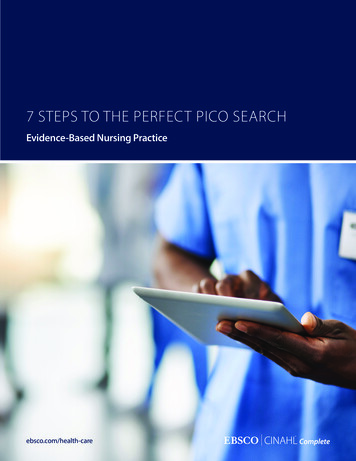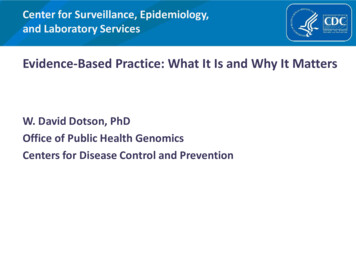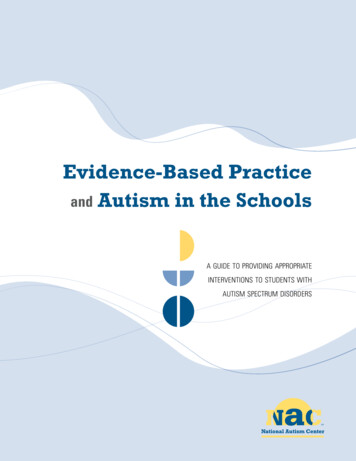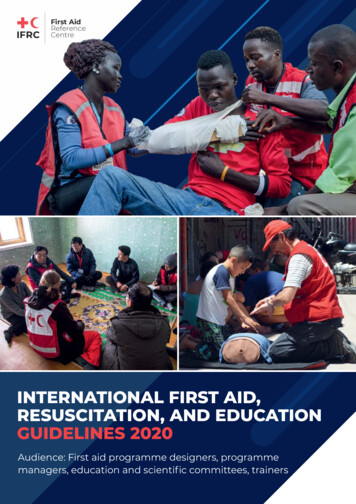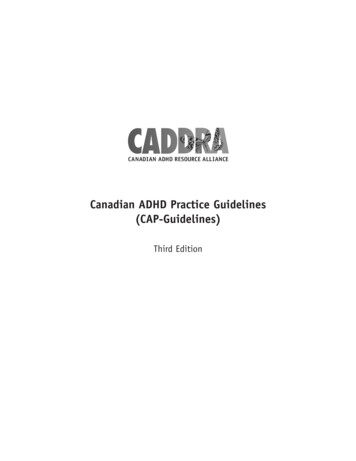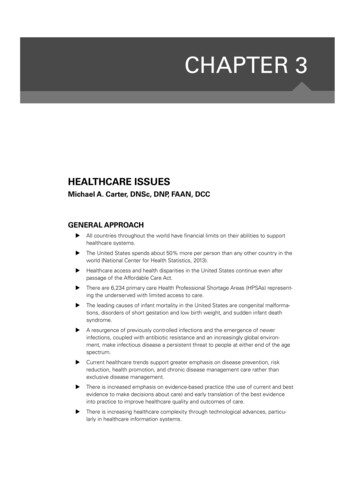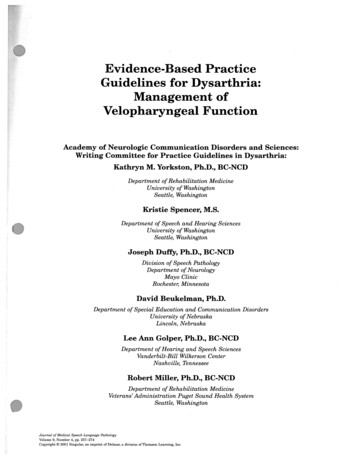
Transcription
Evidence-Based PracticeGuidelines for Dysarthria:Management ofVelopharyngeal FunctionAcademy of Neurologic Communication Disorders and Sciences:Writing Committee for Practice Guidelines in Dysarthria:Kathryn M. Yorkston, Ph.D., BC-NCDDepartment of Rehabilitation MedicineUniversity of WashingtonSeattle, WashingtonKristie Spencer, M.S.Department of Speech and Hearing SciencesUniversity of WashingtonSeattle, WashingtonJoseph Duffy, Ph.D., BC-NCDDivision of Speech PathologyDepartment of NeurologyMayo ClinicRochestei MinnesotaDavid Beukelman, Ph.D.Department of Special Education and Communication DisordersUniversity of NebraskaLincoln, NebraskaLee Ann Golper, Ph.D., BC-NCDDepartment of Hearing and Speech SciencesVanderbilt-Bill Wilkerson CenterNashville, TennesseeRobert Miller, Ph.D., BC-NCDDepartment of Rehabilitation MedicineVeterans’ Administration Puget Sound Health SystemSeattle, WashingtonJournal of Medical Speech Language PathologyVolume 9, Number 4, pp. 257—274Copyright 2001 Singular, an imprint of Delmar, a division of Thomson Learning, Inc.
258JOURNAL OF MEDICAL SPEECH-LANGUAGE PATHOLOGY,VOL.9, NO. 4Edythe Strand, Ph.D., BC-NCDDivision of Speech PathologyDepartment of NeurologyMayo ClinicRochester; MinnesotaMarsha Sullivan, MA.Munroe-Meyer Institute for Genetics and RehabilitationUniversity of Nebraska—OmahaOmaha, NebraskaThe Academy of Neurologic Communication Disorders and Sciences(ANCDS) established a writing committee to develop evidence-based practice guidelines for speech-language pathologists who treat individuals with dysarthria. The current guidelines drawfrom both the research literature and expert opinion and address the issues of management of velopharyngeal impairment in dysarthria. A search ofelectronic databases(PsychlNFO, MEDLINE, and CINAHL) and hand searches of relevant edited booksyielded 33 intervention studies in the categories of prosthetics, surgeryand exercise. Asummary of quality of evidence is provided along with a clinical decision-making flowchart for the management of velopharyngeal impairment in both degenerative and stable/recovering dysarthria. Palatal lift intervention was found tobe effective in selectedindividuals with dysarthria. The best candidates have a flaccid softpalate, pharyngealwall movement, good oral articulation and respiratory support, anda stable diseasecourse. Recommendations for future research are provided.BACKGROUNDDysarthria is a heterogeneous group of neurological speech disorders whose characteristics reflectabnormalities in the strength, speed, range, timing,or accuracy of speech movements as a result ofpathophysiologic conditions such as weakness,spasticity, ataxia, rigidity and a variety of involuntary movements (e.g., dystonia, tremor). Dysarthrias can affect the respirators laryngeal, velopharyngeal, and oral articulatory subsystems,singly or in combination. The impact of dysarthriaranges from a barely appreciable speech disorder toa reduction in the intelligibility of speech to an inability to speak. This group of disorders variesalong a number of dimensions, including age of onset (congenital or acquired at any age), cause (vascular, traumatic, neoplastic, and so on), naturalcourse (developmental, recovering, stable, degenerative, and so on), site of lesion (many sites in thecentral or peripheral nervous system or both), neurologic diagnosis (Parkinson disease, traumaticbrain injury, cerebral palsy, amyotrophic lateralsclerosis, and so on), and pathophysiology (flaccidity, spasticity, ataxia, rigidity, and so on). The challenges inherent to the clinical management of persons with dysarthria are numerous. Speech-languagepathologists are faced with a myriad of assessmentapproaches and treatment techniques—many withpotential utility for an individual client—but somewith dubious validity and utility. Converging evidence in the research literature can serve as thefoundation for the development of guidelines forclinical practice.Mission StatementThe Writing Committee for Practice Guidelines inDysarthria is charged by the Academy of Neurologic Communication Disorders and Sciences (ANCDS)with developing evidence-based practice guidelinesfor speech-language pathologists. (For a review ofevidence-based practice and practice guidelines asapplied to the field of speech-language pathologysee Yorkston et aL, 2001.) These practice guidelinesstem from an evidence-based review that draws
EVIDENCE-BASED PRACTICE GUIDELINES FOR DYSARTI{RIAfrom the research literature as well as expert opinion. They address some of the major issues in themanagement of children and adults with dysarthria. Practice guidelines are intended for use inmaking clinical decisions about the management ofspecific clinical problems. In this article, guidelinesfor the management of velopharyngeal impairmentin dysarthria are reviewed.JustificationThe Writing Committee of Practice Guidelines forDysarthria developed a list of clinical questionsfaced by speech-language pathologists caring forindividuals with dysarthria. The topic of management of velopharyngeal impairment was selectedfor a number of reasons. First, it is a common manifestation of dysarthria and can complicate all aspects of speech production. Second, variation in approaches to management exists in clinical practice.Finally, the intervention literature is substantialand dates back to the 1960s.259zation, 1999). The term velopharyngeal impairment refers to any failure of the velopharyngealmechanism to open or close in a normal fashion forspeech (Tomes & Kuehn, 1996).PROCEDURES: REVIEWINGTHE EVIDENCEDevelopment of practice guidelines can be viewedas a process of translating evidence from both research literature and expert opinion into recommendations for clinical practice. To evaluate thequality of any practice guideline, it is important todocument exactly how they were developed. Thedevelopment process typically involves a series ofsteps (Trombly, 1995) as summarized in Table 1.The following section provides specifics about theexperts (including both the writing committee andthe reviewers), the searches, criteria for inclusionof studies, and rating of evidence.The Writing CommitteeTerminologyThrough the years, a number of terms have beenused to describe velopharyngeal disorders in thecleft palate and motor speech populations. Theseinclude velopharyngeal impairment, inadequacy,insufficiency, incompetency, and dysfunction. In arecent state of the art review; Kuehn and Moller(2000) suggest that there is no universal agreement on distinctions among these terms. They suggest use of the term velopharyngeal impairmentbecause it encompasses a wide variety of velopharyngeal disorders and because it is consistent withterminology used in the World Health Organization’s classification system (World Health OrganiFirst, a group of experts (the writing committee)was convened. These individuals represented abroad range of clinical experience in the management of dysarthria. The initial tasks of the writingcommittee were to clariIr assumptions upon whichthe guidelines are based, to identify pertinent clinical questions, and to define the scope of the literature to be evaluated.The SearchesNext, an intensive literature search was conductedand appropriate intervention articles were retrieved. The following electronic databases wereTABLE 1. The sequence of activities for development of practice guidelines. A panel of experts (the writing committee) is convened Assumptions are clarified and pertinent questions are identified An intensive literature search is conducted and pertinent articles are retrieved Intervention studies are rated for quality of evidence A technical report is drafted that summarized the research literature as well as the expert opinion of thewriting committee Expert opinion is obtained Recommendations are drafted, reviewed, and revised Guidelines are distributed.
260JOURNAL OF MEDICAL SPEECH-LANGUAGE PATHOLOGY, VOL.9, NO. 4searched: PsychINFO covering 1,300 journals (1967to July 2000), MEDLINE covering 3,900 journals(1966 to July 2000), and CINAHL covering 600 journals (1982 to July 2000). The initial searches werekeywords paired with the term dysarthria, for example, dysarthria and velopharyngeal, dysarthriaand hypernasality, dysarthria and resonance. Latersearches paired terms such as velopharyngeal, hypernasality, and resonance with the terms speechand treatment. Because the intent was to carry outthe broadest possible search, other sources of evidence were also sought. In addition to the electronic searches, hand searches of relevant edited booksin the field of dysarthria and ancestral searches ofextant references (e.g., studies cited within an article or chapter) were conducted.Criteria for Inclusion of StudiesThe general search on the topic of dysarthria yielded 1,042 references. From this large search, references related to velopharyngeal function wereidentified, and those related to intervention wereobtained and rated. Intervention studies were defined as those focusing on treatment of the velopharyngeal system that was applied to at least one person with dysarthria. Thus, articles were excludedthat (a) described but did not treat velopharyngealfunction in dysarthria, (b) applied treatment approaches to individuals without impairment, and(c) studied techniques for management of velopharyngeal impairment associated with disorders otherthan dysarthria, (e.g. cleft palate). Review articlesand chapters that surveyed intervention served assupportive documentation for a flowchart of management decisions described later in this article.Rating the EvidenceEach intervention study was analyzed for methodological rigor. Strength of evidence was rated according to principles outlined by the American Psychological Association (Chambless & Hollon, 1998)and was determined by asking the following seriesof questions:How well were the subjects described?How well was the treatment described?What measures of control were imposed in thestudy?Were the consequences of the intervention welldescribed?The rating scheme is described more fully elsewhere (Yorkston et al., 2001). A table of evidencewas then created that contained a summary of eachstudy and allowed comparisons among studies andover time.Expert ReviewsThe quality of evidence found in the interventionliterature along with the expert opinion of the writing committee was summarized in a technical report. A draft of this report was made available to alarger panel of expert reviewers. In the case ofthese practice guidelines for management ofvelopharyngeal impairment, the technical reportwas reviewed by 28 experts in addition to the writing committee. A majority of these individuals holddoctoral degrees (6 1%). The average length of clinical practice was 19 years. Although most of the expert reviewers were members ofANCDS (68%), theopinion of reviewers from outside of the organization’s membership with known expertise onvelopharyngeal function was also sought. The comments of the expert reviewers were carefully considered and used to modify the technical report. Finally, the guidelines were distributed in the form ofboth a technical report, made available on the websites of ANCDS (http://www.duq.edulancds/) andASHA (http:llwww.asha.org[), and published in thisclinically focused article.SUMMARY OF EVIDENCE FROMINTERVENTION STUDIESA total of 33 intervention studies were identified,obtained, and rated by at least two members of thewriting committee. A sunirnary of the table of evidence in which the studies were rated can be foundin the technical report. The following section provides an overview of the evidence, including thetypes of interventions and management of velopharyngeal impairment in dysarthria.What Interventions Are Reportedin the Research Literature?The intervention studies were classified into threecategories: prosthetic, surgical and exercise. Prosthetic intervention included palatal lifts, nasal, ornasopharyngeal obturators and palatal desensitization associated with palatal lift fitting. Surgicalintervention included pharyngeal flap surgery,
261EVIDENCE-BASED PRACTICE GUIDELfl’ES FOR DYSARTHRIApharyngeal implants, and teflon injections. Exercise included palatal training devices and resistance exercises with continuous positive airwaypressure (CPAP). Table 2 contains a summary ofthe types of interventions for velopharyngeal impairment reported in research articles over a 30year period. Also included in Table 2 is the numberof subjects in each category The largest categorywas prosthetic intervention with 21 studies (61% ofthe total) followed by the surgical category with 9articles (27% of the total), and the exercise category with 2 articles (6% of the total). When intervention options were compared in terms of the numberof cases or subjects reported, palatal lift intervention was by far the most common with 83% of subjects (186 of 224) receiving palatal lifts. Sixteenpercent of subjects received pharyngeal flapsurgery. However, since 1990, only 2 cases of pharyngeal flap surgery were reported.It is also important to note interventions thatwere not documented in the literature. This extensive search of the published literature found no evidence supporting the following techniques: pushing techniques; strengthening exercises, such asblowing and sucking; tasks that encourage the patient to control and modify the airstream usingballs, whistles, candles, fluff; powder, paper bubbles, straws, and so on; and inhibition techniques,such as prolonged icing, pressure to muscle insertion points, slow and irregular stroking and brushing, and desensitization.A review of the current research suggests thatthere is not sufficient evidence to assess the effectiveness of surgical management or exercise forvelopharyngeal impairment in dysarthria. In thearea of exercise, only two case reports have beenpublished. In the area of surgical intervention, evidence is insufficient to make recommendations. Early reports draw from the field of cleft palate. In fact,the first report of pharyngeal flap intervention inneurologic populations was entitled, “Cleft palate-type speech in the absence of cleft palate” (Randall,Bakes, & Kennedy, 1960). Other studies publishedprior to 1970 are called “preliminary” reports(Hardy, Rembolt, Spriestersbach, & Jaypathy, 1961)and lack both the detailed case descriptions andcomprehensive outcome measures needed for documentation of effectiveness. Often surgical intervention was described in complex cases, such as the casereported by Johns (1985) of an individual with agunshot wound to the left frontal lobe and themandible or in cases where behavioral and prosthetic intervention had already failed. Thus, the cornplenty of the cases makes generalization to a broader population difficult. Palatal lift intervention wasfirst reported as a response to apparent dissatisfaction with pharyngeal flap surgery. Hardy and hiscolleagues, who had in 1961 authored one of the firstreports of pharyngeal flap surgery, published astudy of palatal lift intervention in 1969. As a rationale for the palatal lift intervention, they cited difficulty in predicting the successful outcome with pharyngeal flap surgeries. Thus, recommendations forthe appropriateness of surgical intervention cannotbe offered at this time given the insufficient foundation of applicable research.Evidence for the Effectivenessof Prosthetic InterventionBecause intervention studies in the area of prosthetic management are the most common and provide an adequate picture of candidates and outcomes of intervention, the following sections willhighlight the effectiveness prosthetic intervention.Who Is a Good Candidate forProsthetic Intervention?Because dysarthria represents a heterogeneousgroup of disorders, identifying good candidates forintervention is dependent in part upon the qualityTABLE 2. Number of articles in various intervention categories andtotal number of participants.Timeframe19701970s1980s1990 thru 7/00Total (9)(18)(1)(6)(35)Parentheses indicate the total number of subjects.ExerciseTotal6 (21)1 (1)12 (96)1 (2)2 (3)7 (64)7 (42)33 (224)
262JOURNAL OF MEDICAL SPEECH-LANGUAGE PATHOLOGY VOL.9, NO.4of the description of subjects. Studies reviewedhere included descriptions of subject characteristics that ranged from comprehensive to minimal.The following characteristics were reported in atleast 50% of the studies: age, gender, medical diagnosis, time post onset, speech characteristics, treatment history, severity of dysarthria, physiologic data, and data from the neurologic examination.Intervention for velopharyngeal impairment wasstudied most frequently in individual s with traumatic brain injury (TBI), cerebrovascular accident(CVA), and cerebral palsy (CP). Although motorneuron disease was only reported in 5 of the 32 articles (16%), a recent study (Esposito, Mitsumoto, &Shanks, 2000) reported the results of palatal lift fitting in a group of 25 speakers with amyotrophiclateral sclerosis.The type of dysarthria was not specified for someor all of the subjects in 75% of the articles. However, when the type of dysarthria was specified (as itwas in 37% articles), flaccidity was a component inmost cases. The second most common type ofdysarthria was a mixed flaccidlspastic dysarthria.The relatively low rate of reporting dysarthria typelikely reflects the historical development of thefield. The first study reporting type of dysarthria(flaccid reported in Netsell and Daniel, 1979) occurred only after the publication of the classicMayo Clinic studies of differential diagnosis indysarthria (Darley, Aronson, & Brown, 1969a,1969b; Darley, Aronson, & Brown, 1975).In reviewing the description of candidacy and therationale for intervention contained in the studies,the following general categories emerged:Speech Characteristics. Several speech characteristics were associated with candidacy includinghypernasality, nasal emission, and severe reduction in intelligibility.Physiologic Factors. The deficient functioning ofthe velopharyngeal mechanism was identified frequently as a rationale for intervention under thiscategory This included characteristics such asvelopharyngeal incompetence, palatopharyngealparalysis, inconsistent soft palatal contact with thepharyngeal wall, and inability to achieve adequateoral pressure. Poor respiratory support also was indicated as a physiologic rationale for management.Resolution of Symptoms. The notion that resolution of the velopharyngeal incompetence wouldlead to speech improvement was cited as a rationalefor intervention. At times, this premise was expressed in procedural phrases, such as “improvedproduction of plosives and fricatives with manualocclusion of the nares” (Stewart & Rieger, 1994, p.151).History of Previous Intervention. The historyof previous interventions was a common rationalefor decisions made about the chosen course of therapy. For example, behavioral speech treatment hadbeen unsuccessful or progress had plateaued at thetime when intervention was undertaken.Natural Course of the Disease. The course ofthe disease also was used to determine candidacy.For example, cases with the diagnosis of traumaticbrain injury were reported where the time post onset suggested that no further speech recovery waslikely.Professional Judgment. Generic statementsabout professional judgments also served as a rationale for intervention. These included statementssuch as a “multidisciplinary evaluation was used todetermine candidacy” (Stewart & Rieger, 1994, p.151). The category of professional judgments alsoincluded statements such as “other approachessuch as surgery were contraindicated” (Gonzalez &Aronson, 1970, p. 92) and “interventions werejudged to be effective for other populations particularly those with craniofacial abnormalities” (Crikelair, Kastein, & Cosman, 1970, p. 182).Patient Preferences. Statements that can becategorized as patient preferences also emerged indiscussions of candidacy (e.g., the patient was notsatisfied with the palatal lift, the palatal lift wasinconvenient and embarrassing in social situations, and the patient desired to permanently reduce the impairment).How Do We Know That Treatment Works?One of the traditional ways of evaluating the quality of evidence that treatment works is to rate thetype of study. Studies that randomly assign subjects into groups are generally considered the highest quality. Nonrandomized group studies or casesubjects are generally considered to provide lesspowerful evidence. Given the heterogeneity of thedysarthria population, rating of evidence by type ofstudy has been called into question. (See Yorkstonet al., 2001, for a more complete discussion of themerit of various systems for rating evidence.) In
EVIDENCE-BASED PRACTICE GUIDELINES FOR DYSARTHRIAthe current group of intervention studies focusingon prosthetic management, 186 individuals withdysarthria were included.The psychometric adequacy of measurement wasassessed by indicating whether information wasprovided regarding reliability and stability of themeasurement of the outcomes. For example, interor intra-rater reliability, dispersion of judges’scores, and comparison of measures to a gold standard were all considered evidence of psychometricadequacy. Unfortunately, this type of evidence wasoften lacking. Although a trend over time towardmore rigorous measures was noted, the majority ofcurrent studies do not report evidence of psychometric adequacy. Overall, approximately 20% ofthe studies provided data about the psychometricadequacy of the measures used.Another way of rating the quality of evidence is toevaluate the strength of control imposed by thestudy; In other words, does support exist for the assertion that the treatment of interest was responsible for the change in behavior/outcome measuresrather than some other explanation? Several studiesreported comparisons of measures of speech adequacy with and without the palatal lift. This can providestrong evidence of internal validity (i.e., the palatallift was responsible for the change in outcome).Among other indicators that interventions such aspalatal lifts were successful was the fact that speechperformance had not improved with many years ofbehavioral intervention. Therefore, improvementscould be attributed to palatal lift intervention. Thetrajectory of the disease also was cited as support ofthe effectiveness of intervention. For some, the disease course was degenerative and intervention maintained a given level of speech production in the faceof progression of the underlying impainnent. For others, improvement in chronic and stable conditionswas cited as support of intervention effectiveness.What Risks or Complications ofPalatal Lifts Were Identified?The benefit of any intervention must be weighedagainst the risks or complications inherent to thetreatment. Generally, the risks or complications ofpalatal lift fitting were minor. Some studies suggested that tooth movement or injury to the soft tissue were risks, but none of the studies reported itsoccurrence in any subjects. The most common complication of palatal lift fitting was intolerance inthe form of initial discomfort, inability to inhibit agag, and prosthesis retention difficulty. Some negative speech-related changes were also reported,263such as difficulty with articulation, due to increased tonicity in laryngeallpharyngeal musculature in some patients with severe spasticity. Increased swallowing difficulty and hypersalivationfor short periods were also reported. Finally, someauthors reported a patient’s lack of acceptance ofthe device and unrealistic expectations.What Were the Outcomes ofthe Intervention Studies?Generally, the studies of palatal lift fitting reportedpositive outcomes. Although criteria for successvary; treatment was judged successful 76% of thetime in a series of 25 cases reported by Bedwinekand O’Brian (1985). Optimum results were obtained in 32 and positive outcomes in 96% of 44cases reported by LaVelle and Hardy (1979). Someof the most common outcomes included improvedarticulation, improved speech intelligibility, decreased hypernasality, and more efficient use ofrespiratory support for speech. A more complete description of potential outcome measures can befound in the measurement of outcomes section thatfollows. Palatal lift fitting was found to be successful, but more difficult, in individuals who wereedentulous or had a spastic palate. The best resultswere reported when the soft palate was flaccid andwhen good pharyngeal wall movement was present. Most improvement was noted in individualswho wore their lifts the longest.Some of the early descriptions of palatal lift fitting (e.g., Mazaheri & Mazaheri, 1976) posed anumber of questions for further investigation. Forexample, what is the relationship between thepalatal stimulation offered by palatal lift fittingand the degree of neuromuscular function and recovery? Although many clinicians have workedwith individuals who have experienced improvement in neuromuscular function after palatal liftswere fitted, studies of groups of patients fitted withpalatal lift prostheses did not support a strong association between palatal lift fitting and recovery ofvelopharyngeal function (Witt et al., 1995).Personal testimonies of speakers with dysarthriawho use a palatal lift are also a source of information about treatment outcomes. Two of the individuals with ALS who participated in the Esposito etal. study (2000) were interviewed by CBS Healthwatch (URL: www. cbshealthwatch.medscape, accessed 6/00). Both linked use of the lift to their continued ability to work. One individual, a financialplanner stated, “My livelihood is based on my communication skills. It is vital for me to be able to ex
JOURNAL OF MEDICAL SPEECH-LANGUAGE PATHOLOG VOL.9, NO. 4264press my thoughts.” The other; a business manager,stated, “I doubt if I could work very effectively without the palatal lift.”CLINICAL DECISION MAKINGThe following presents an overview of clinical decision-making about management of velopharyngealimpairment in dysarthria. It is derived from conclusions drawn from the evidence examined earlieralong with expert opinion both from the publishedliterature and a panel of reviewers. Figure 1 illustrates a clinical decision-making flowchart for themanagement of velopharygeal impairment indysarthria. The following section provides a detailed explanation of various aspects the flowchartas well as a review of assumptions about the management of dysarthria,AssumptionsBefore describing the flowchart, it is necessary toreview some of the assumptions upon which it isbased. These assumptions are presumed to be trueas they relate to the practice of speech-languagepathology.Goal of Intervention. Enhancement of speechand communication function is a fundamental target of intervention.Uniqueness of Speech. Speech motor control isunique and different from other motor systems.Therefore, it must be assessed as part of a comprehensive physical examination and cannot be presumed from neurologic deficits in other systems,such as in limb function.inFigure 1. Diagram for clinical decision making for management of velopharyngeal impairmentdysarthria.
EVIDENCE-BASED PRACTICE GUIDELINES FOR DYSARTHRIAIndividual Assessment. The pattern and severity of impairment in the various speech subsystemsvaries from one population to another and from oneindividual to another within each population.Therefore, the pattern and severity of impairmentmust be assessed individually.Individual Intervention. Interventions vary asa function of type of dysarthria, severity of dysarthria, and co-existing factors. Therefore, individual intervention plans must be developed.Staging of Intervention. Dysarthria often is nota stable condition. For example, children with developmental dysarthria may experience physiologic changes affecting speech production as they mature. Adults with acquired dysarthria mayexperience phases of recovery; as in dysarthria associated with traumatic brain injury; or phases ofdegeneration, as in dysarthria associated withamyotrophic lateral sclerosis. Therefore, the staging of intervention (i.e., the timing of treatment) iscritical for successful outcomes.Appropriate Referrals. Practice will be conducted by competent speech-language pathologists whorefer to other disciplines when appropriate (e.g., forprosthodontic consultation when a palatal lift prosthesis is considered appropriate).Clinical Competence. Practice will be conductedby competent speech-language pathologist in anappropriate and efficient manner.Disclosure. Clinicians will communicate boththe benefits and risks (including financial) of thetreatment.Assessment of VP FunctionAssessment of velopharygeal function in speakerswith dysarthria assumes an understanding of normal function. While it is beyond the scope of this article to review normal velopharyngeal function, excellent sources of information are available (e.g.,Kuehn & Mollei 2000). The following section summarizes the components of an assessment ofvelopharyngeal function in dysarthria that may beconsidered depending on the constellation ofdeficits and the desired outcomes of each client. Assessment consists of four components: history taking, speech evaluation, physical examination, andexamination of the velopharyngeal mechanism.265History TakingThis phase of the assessment involves gatheringpertinent information from the patient, the medicalrecords and the referral source. Information shouldbe gathered on areas such as the following: the onset of symptoms and medical/dentalhistory the nature, duration, and natural course ofvelopharyngeal (VP) impairment reports of previous treatment the level of concern about the problem(Netsell, 1988) the patient’s motivation relative to treatment (Wolfaardt, Wilson, Rochet, & McPhee,1993)Speech EvaluationDeter
Mayo Clinic Roche ster; Minnesota Marsha Sullivan, MA. Munroe-Meyer Institute for Genetics and Rehabilitation University of Nebraska—Omaha . stem from an evidence-based review that draws. EVIDENCE-BASED PRACTICE GUIDELINES FOR DYSARTI{RIA 259 from the research literature as well as expert opin ion. They address some of the major issues in the



